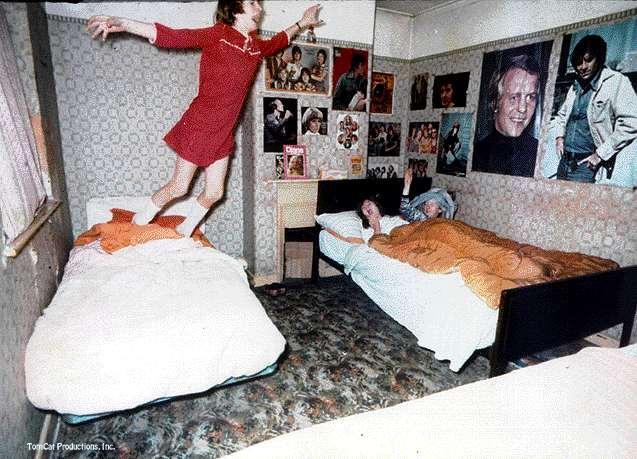|

|
Poltergeist
(help·info) (from German poltern,
meaning "to rumble", "to make a noise" and Geist, meaning "ghost" or "spirit") is in mythology and folklore a ghost, spirit,
entity, demonic spirit or being that manifests itself by creating noise or
moving objects.
Poltergeist manifestations have been reported in many cultures, and are part
of folklore in India, the United
States, United Kingdom, Japan, Brazil and other countries. True believers in the
supernatural often claim that no stable scientific explanation exists to
date, although
several physical theories have been occasionally proposed (some including
tremors, air currents, ultra-infra sound waves or unexplained losses of gravity)
to produce purported effects. Since there is no proof of the existence of
poltergeists the consensus of opinion from the scientific community is that the
evidence claimed by believers is all in the mind or caused by scientifically
explainable phenomena (e.g air currents, tremors). By definition science cannot
disprove the existence of poltergeists since it is impossible to prove a
negative. Although poltergeist stories date back to the first century, the evidence
supporting the existence of poltergeists is entirely unsubstantiated. Many of
the stories below have several versions and/or inconsistencies.
Lithobolia, or the Stone-Throwing Devil, is a pamphlet that records
poltergeist activity that took place in the tavern of George and Alice Walton in
1682. Two copies of the pamphlet exist in the British Museum. The Waltons' tavern was located
in New Castle, New Hampshire, then known
as the Great Island. Lithobolia was written by “R.C.,” one Richard Chamberlain,
the secretary of the colony of New Hampshire. In 1682 Chamberlain was boarding
at the Walton tavern and witnessed the attack.
The pamphlet was later printed in London by Chamberlain in 1698. The opening
reads:
"Lithobolia," or stone
throwing Devil. Being an Exact and True account (by way of Journal) of the
various actions of infernal Spirits or (Devils Incarnate) Witches or both: and
the great Disturbance and Amazement they gave to George Walton's family at a
place called Great Island in the county of New Hampshire in New England, chiefly in throwing about (by an
Invisible hand) Stones, Bricks, and Brick-Bats of all sizes, with several other
things, as Hammers, Mauls, Iron-Crows, Spits, and other Utensils, as came into
their Hellish minds, and this for space of a quarter of a year."
William Roll, Hans Bender, and Harry Price are perhaps three
of the most famous poltergeist investigators in the annals of parapsychology.
Harry Price investigated Borley Rectory which is often called "the most
haunted house in England."
Dr. Friedbert Karger was one of two physicists from the Max Planck
Institute who helped to investigate perhaps the most validated poltergeist
case in recorded history. Annemarie Schneider, a 19-year-old
secretary in a law firm in Rosenheim (a town in southern Germany) was seemingly the unwitting cause of much
chaos in the firm, including disruption of electricity and telephone lines, the
rotation of a picture, swinging lamps which were captured on video (which was
one of the first times any poltergeist activity has been captured on film), and
strange sounds that sounded electrical in origin were recorded. Fraud was not
proven despite intensive investigation by the physicists, journalists and the
police. The effects moved with the young woman when she changed jobs until they
finally faded out, disappeared, and never recurred.
In the Rosenheim case of 1967, The Rosenheim
Poltergeist (1967), Friedbert Karger's whole perspective on physics changed after investigating the
events. "These experiments were really a challenge to physics," Karger says
today. "What we saw in the Rosenheim case could be 100 per cent shown not to be
explainable by known physics." The phenomena were
witnessed by Hans Bender, the police force, the CID, reporters, and the
physicists. The case was made into a documentary by the BBC in 1975 as part of a
TV series called "Leap
in the Dark.
- Drummer of
Tedworth (1662).
- The "Wizard", Livingston, West Virginia (1797).
- The
Bell Witch (1817).
- The Haunting of The Fox
sisters (1848) – arguably one of the most famous, because it started the Spiritualism movement.
- The Great Amherst Mystery, 1878–79.
- Hopfgarten near Weimar (1921).
- Eleonore
Zugun – The Romanian 'Poltergeist Girl' (1926).
- The Epworth Rectory
- The Wayne,
NJ (1931)
- The Black Monk of Pontefract
- The possession case of Robbie Mannheim
(1949)
- The Enfield
Poltergeist (1977).
- The Mackenzie Poltergeist (1998–) – Famed
for haunting Greyfriars churchyard, Edinburgh.
- The Canneto di Caronia fires poltergeist
(fairly recent (2004–2005)) – Famed for defying all attempts at a scientific
explanation, Sicily, Italy.
- The case of Tina Resch,
widely reported in the media in 1984.
- A 2009 case in Barnsley near Sheffield in England, where either
poltergeist effects or a faulty cistern were witnessed by police.
- The Thornton Road poltergeist of Birmingham (1981).
- 1 LaVeta Place, Nyack NY – See Stambovsky v. Ackley, 169 A.D.2d 254
(NY App. Div. 1991) (where the Appellate Division of New York's Supreme Court
held that the buyer of the home at 1 LaVeta Place could rescind the purchase
contract because the seller failed to disclose to the buyer that the house was
haunted by poltergeists).
- Easington Council in County Durham,
UK paid half of a medium's
exorcism fee to remove a poltergeist
from council housing in Peterlee,
deemed more cost effective than relocation of the tenant (2008)
- The Miami Poltergeist, a poltergeist witnessed by police and a skeptic who
admitted he could not explain the phenomenon. Many others witnessed phenomena
including reporters, parapsychologists, and workers at the warehouse.
- The Mysterious case of Gef the Talking Mongoose.
Historically, several different hypotheses have been put forward to explain
the poltergeist phenomenon.
|
 Copyright(c) 2007
- 2020. All rights reserved. Copyright(c) 2007
- 2020. All rights reserved.
|

![]() Copyright(c) 2007
- 2020. All rights reserved.
Copyright(c) 2007
- 2020. All rights reserved.